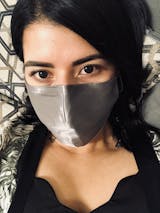If you're over the age of 25, chances are you'll have thought about getting cosmetic injections. These face-smoothing, skin-plumping, youth-enhancing doses with almost instant results have grown in popularity in the beauty industry over the past decade or so. But do you really know what's in them?
Facial Injections: 3 Types
There are three types of facial injections on the market that all do different things. These are:
- Botox®: used to reduce wrinkles by temporarily paralyzing the muscles.
- Dermal Fillers: used to plump areas, usually on the face.
- Kybella®: used as a fat remover in areas, such as a double chin.
We’ll discuss each injectable, what they do, the possible risks of using each, and we’ll also give you safer alternatives.
What is Botox®?
First of all, let’s talk about Botox®. Botox® is made from a protein called botulinum toxin. There are varying levels of botulinum toxin. Depending on their molecular size, biosynthesis, and cell mechanisms, they can be type A through to G. Botox® is the most potent kind, type A.
Botulinum toxin is one of the most toxic chemicals2, and in large doses can be incredibly dangerous, and in some cases lethal. But when used in small doses as a cosmetic injectable, it is deemed safe by the FDA with most people having no serious side effects.
It works by preventing neurotransmitters to release, which causes almost instant, but temporary paralysis of the muscles. Doctors first used Botox® in small doses in 1989 to treat Strabismus and blepharospasm (crossed-eyes). Then in 2002, it was approved by the FDA for cosmetic use, and is now the most popular cosmetic procedure, with an estimated over 3 million injections per year3.
Botox® is technically a brand name, but is basically any injectable that contains botulinum toxin type A. It also goes by other brand names such as Dysport/Azzalure, Xeomin/Bocouture, and Jeuveau.
The dosage is low, and as mentioned before, is believed to be safe for cosmetic use. But in medical uses, the dosage is usually higher than cosmetic doses, and a 2016 study1 found that botulinum toxin leads to loss in tissue density and bone volume.
We’re coming up to 20 years next year since Botox® was approved by the FDA. While there have not been any severe side effects or deaths, perhaps it hasn’t been in use long enough to know the long-term problems it could potentially cause when used as a cosmetic injection.
We all know of such cases where something had been approved by the FDA, but later came to light that it was harmful to our health (I’m looking at you talcum powder…).
What are Fillers?
The second injectable on the list are fillers. Fillers are a clear liquid that is injected into areas on the face and body to give the appearance of being fuller and more plump.
Fillers used to be made solely from collagen, but now most fillers are made from hyaluronic acid (HA). Both chemicals are naturally found in the body & are absorbed into the body after a few months.
What is Collagen?
Collagen is the most abundant protein in mammals, and is what gives our skin that plumpness and elasticity. As we age, collagen production slows down, which leads to sagging skin, fine lines, and wrinkles.
What is Hyaluronic Acid?
Hyaluronic acid is found predominantly in your skin, eyes and connective tissue, and it attracts and holds 1000 times its weight in water. It gives a more radiant and hydrated appearance to your skin. Most of us benefit from a hyaluronic acid serum, particularly as we age.
What is the Difference Between Collagen and Hyaluronic Acid Fillers?
According to SB Aesthetics, “Collagen-boosting injectables work by stimulating your body's natural production of collagen in your skin, leaving you with a more supple, smoother face. Hyaluronic acid-based injectables work by plumping up soft tissue and absorbing water molecules, leaving you with refreshed, more hydrated skin.”
What is Kybella®?
Kybella® is a brand name for deoxycholic acid, and is also known as deoxycholate and cholanoic acid. It is a naturally-occurring bacteria produced by the liver that is effective at dissolving adipose (fat) tissue.
Deoxycholic acid has been used in medical settings to dissolve gallstones and lipomas (non-cancerous fat tumors). Kybella® was FDA-approved in 2015 initially as a way to remove a double-chin, and has since been approved for use on other parts of the body.
Injectable Ethics
Apart from the fact that many of us are terrified of needles (especially in our face!), another reason why many of us may want to reconsider getting injectables is that they are not an ethical practice.
Anything that is injected into the body beyond the surface of the skin is classed as a "medical-grade" treatment. This means that they must be tested usually on animals in labs before they can be used on humans to check their safety. And even if a "medical-grade" product is classed as "certified vegan", it still needs to go through the same process of testing.
Another point to make is, the cosmetic injectable industry creates a lot of waste—particularly plastic disposables. We get it, it’s for hygiene and safety. But perhaps there’s a better way.
Like Botox®, Only Ethical
For some of us, denying the use of a popular and very effective wrinkle-remover, or skin-plumper, or fat-emulsifier can be a tough decision to make. Especially if many of our friends are going down that route. But for those of you who are either looking for a less invasive solution (as in, no needles in the face, please!), or just want something less clinical, or more ethical, there are a number of other options out there that won’t hurt you, or our furry friends.
There are a few products out there that are vegan and cruelty-free that claim to work just as Botox® works. But when I did little digging, I realized their packaging was plastic, and it really wasn’t a more sustainable option.
The reality is, Botox® and other injectables work quickly, which is why they are so popular. But what do we do in a situation where we want our skin to look more radiant and youthful, but we don’t want to pump our face with chemicals, and we also don’t want to cause the environment more damage?
Look for ingredients and products that have these properties:
- Muscle relaxing
- Skin-smoothing
- Skin-firming
- Muscle toning
Better Alternatives to Injectables
I scoured the internet to find alternatives to unethical and unsustainable face injectables, and this is what I found.
Ingredients
For Botox Effects
These ingredients work best when used everyday for a period of time, and the results are going to be subtle and long-lasting.
Sea Buckthorn: This natural derivative is a great alternative to Botox®, as it increases the skin’s ability for cell turnover and collagen production, while softening the tension.
Find it in UpCircle’s best-selling Organic Face serum with Coffee Oil
Lau Comfrey: A popular botanical used in medicinal and skincare applications. It contains allantoin and rosmarinic acid. Allantoin promotes the growth of new skin cells, which help with regeneration, while rosmarinic acid helps to calm the skin’s muscles, softening facial expressions.
Find it in Honua Skincare’s Aloha Youth Serum
Red Algae Astaxanthin: This antioxidant-rich carotenoid increases blood flow, promotes circulation, which facilitates cell turnover, while improving skin’s elasticity. Expressions are softer and more relaxed.
Find it in Earth Harbor’s Helios Anti-Pollution Youth Ampoule.
For Lip Filler Effects:
Admittedly, there are no natural alternatives that are as effective as injectable fillers that I could find. But if you want a subtle change, try one of these methods.
Peppermint Oil: Massage onto dry lips for a few minutes, then remove. Lips will feel tingly, but will also look fuller for a few hours.
Cayenne Pepper and Olive Oil: While this can be quite an intense burn, your lips will look fuller and the cayenne pepper will stimulate blood flow to your lips.
Cinnamon and Olive Oil: This works similarly to cayenne pepper, but won’t burn or give such a red pigment to the lips.
For Kybella Effects:
Some people swear by using ice packs and ice baths to quite literally freeze their fat. But if it were as simple as that, we’d all be doing it. There are no real quick “fat emulsifying” treatments you can use at home, but there are two other non-injectable treatments available in certain clinics.
The first one is CoolSculpting, where fat is cooled down and crystallized and essentially killed off. The second method is Ulthera, an ultrasound energy that firms and tightens the localized area. Both treatments are expensive, and it’s unclear to me whether these are completely ethical and sustainable options.
Treatments
FaceXcise
As the name suggests, it’s a facial exercise technique of cupping and massage to improve circulation and blood flow, which in turn helps with boosting the skin’s muscle tone and elasticity.
These rubbery balls were designed by Yamuna Zake, a renowned fitness trainer who began to notice signs of aging on her face. Knowing she did not want to go down the route of Botox®, Yamuna implemented her knowledge of muscles into a revolutionary new product and treatment, the Yamuna Ball, where you roll the face muscles in order to tone them.
Acupuncture
The series of extra-fine needles inserted into acupuncture points on the face create tiny painless wounds, called positive microtraumas, in the skin. The body senses these and begins a process of repair. Simultaneously, the needle stimulation increases blood flow, causing oxygen and nutrients to be sent to the skin cells, and increases the production of collagen. Acupuncture can also help to detoxify the body, getting rid of toxins that can cause wrinkles and redness. All of this helps to smooth the skin, minimize fine lines, improve elasticity, and promote all-around healthier skin.
Daily Habits
Using SPF: The sun is one of the most damaging elements our skin suffers. A study4 done in 2013 found that those who used sunscreen daily were 24% less likely to show increased signs of aging.
Drinking Water: Skin dehydration is one of the leading causes of skin cell degradation. Staying hydrated by drinking plain old water will ensure your skin cells also stay nourished.
Eating Fresh Foods: A diet high in antioxidants is proven4 to slow the aging process. This includes foods like berries, dark leafy greens like kale, and legumes, like kidney beans. It also means to avoid processed foods, sugar, and alcohol as much as possible.
Getting Enough Quality Sleep: We need between 7-9 hours a night for optimal rest. Think about the times you had a bad-night's sleep. I’m guessing you didn’t look your best the next day. If you have trouble getting a good night’s sleep, try these things:
- meditation before bed
- removing screens and electronics from your bedroom
- sleeping on silk sheets
Staying Active: Our bodies need movement to thrive. The more sedentary we are with our lives, the faster our bodies age. As they say, use it or lose it.
Taking Time Off Screens: Since the pandemic began, there has been an increase in the amount of time people spend on their screen. This not only affects our physical activity, but it affects our skin, as the lights that emit from our screen are the same rays that come from the sun, and cause our skin cellular damage. Protect your skin by taking breaks, using screen protectors, wearing blue-light blocking glasses, and blue-light blocking skincare, like Earth Harbor’s Samphire Sea-Retinol Digital Serum.
So, hopefully this has shed some light on cosmetic injectables for you. There are many alternatives out there, you just need to know where to look.
Emma Masotti is an Australian now living in Austin, TX, and has been a trained esthetician for over 15 years. She is a sustainable skincare writer, educating and building awareness around proper skin health that doesn’t cost the earth.
Some of the products promoted in our blog are from our online store. Many others are brands we have researched and found to be great examples of sustainable, ethical, and innovative brands in their field, and we don't make any profit from mentioning them in our blog. #CollaborationOverCompetition










